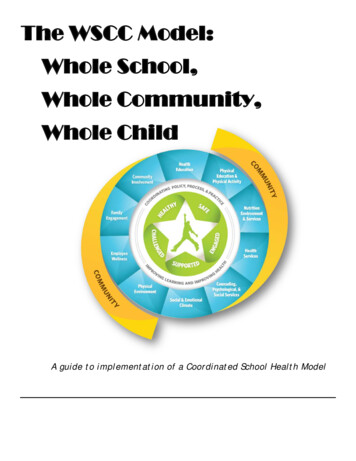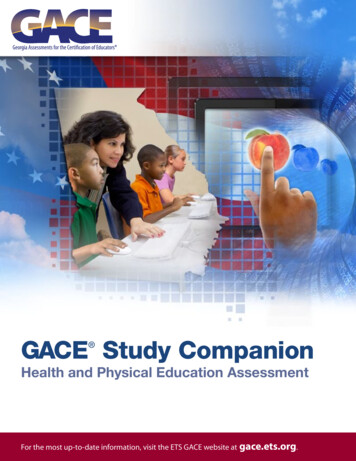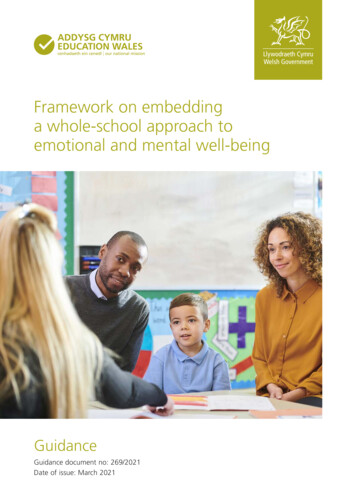
Transcription
The WSCC Model:Whole School,Whole Community,Whole ChildA guide to implementation of a Coordinated School Health Model
AcknowledgementsThanks to the Oklahoma Health Improvement Plan (OHIP) Coordinated School Health Workgroup for creatingthis guide along with other resources. The partners include:2
Tableof ContentsINTRODUCTIONWhat is the WSCC Model?Purpose of ManualHealth and Academic AchievementThe Need for WSCC in Oklahoma4567OVERVIEW AND IMPLEMENTATION OF THE WSCC COMPONENTSHealth Education8Physical Education and Physical Activity10Nutrition Environment and Services12Health Services14Counseling, Psychological, and Social Services16Social and Emotional Climate17Physical Environment19Employee Wellness21Family Engagement22Community Involvement24CALL TO ACTION263
INTRODUCTIONWhat is the Whole School, Whole Community, Whole Child(WSCC) Model?The Whole School, Whole Community, Whole Child (WSCC) model is a combination ofthe CDC’s Coordinated School Health Model and the ASCD’s Whole Child model. WSCCis an ecological approach that is directed at the whole school, with the school in turndrawing its resources and influences from the whole community and serving to addressthe needs of the whole child. The WSCC model puts the child at the center,representing the idea that children and youth should be the focus of decision-making;thus, all policies, practices, and programs should support a healthy, safe, engaged,supported, and challenged child. The WSCC model increases alignment and integrationbetween health and education to improve each child’s cognitive, physical, social, andemotional development; therefore, addressing barriers to every child’s capacity forlearning.A quality WSCC initiative integrates and collaborates between health and educationacross the community, schools, and the WSCC sectors to improve each child’s physical,cognitive, and emotional development.4
INTRODUCTIONThe purpose of WSCCImproving student wellness helps students succeed in school. It is critical thatschools promote health and wellness. Failure to do so may undermine schools’overall goal to provide high quality education for all students. Students are mostinfluenced to lead healthy and productive lives when the schools, parents, andother community groups work collaboratively. Each of these groups has uniqueroles for accessing students, identifying and sharing resources, and impactinghealth behaviors of children and youth. The 10 components of the Whole School,Whole Community, Whole Child model can serve as a catalyst for systemicchanges in schoolsto promote studenthealth andeducationaloutcomes.
INTRODUCTIONThe Role of Health in Academic AchievementResearch shows that schools with a systematic, coordinated, and integrated approach tostudents’ health have fewer incidences of behavioral problems, improved school attendancerates, enhanced interpersonal relationships, and higher student achievement.-Gene Carter, Association for Supervision and Curriculum DevelopmentTHE LINK BETWEEN LEARNING AND STUDENT HEALTHIt is important to understand the closesupportive relationship between healthyschools and students’ achievement.Students who are in good health and whohave their social and emotional needs metcan concentrate better on learning thanthose who are sick or distracted.Schools that create a comprehensiveapproach to health promotion andeffectively address the complete physical,emotional, intellectual, and social wellbeing of students and staff are moreeffective in creating an environment wherestudents can learn.According to Active Living Research, healthylifestyles can have both immediate andlong-term benefits on academicperformance. For example, almostimmediately after engaging in physicalactivity, children are better able toconcentrate on classroom tasks, which canenhance learning. Regular participation inphysical activity has shown links toimproved brain health and standardizedtest scores, increased attention and abilityto stay on task, reduction of disruptiveclassroom behavior, and a decrease inschool absences.Enhanced brain functioning after 20 minutes of walkingBecause emotional and physical health arecritical to the development of the wholechild, health should be fully embedded intothe educational environment for allstudents. “Health and learning”: Is a multifaceted concept thatincludes the intellectual, physical,civic, and mental health of students;Provides coordinated andcomprehensive health efforts thatgive students and staff effectiveteacher, school, family, community,and policy resources;Supports the development of a childwho is healthy, knowledgeable,motivated, engaged, and connected;Is the reciprocal responsibility ofcommunities, families, schools,teachers, and policymakers
INTRODUCTIONWhy is there a need to implement the Whole School, Whole Community, WholeChild (WSCC) model in Oklahoma? 22% of Oklahoma children under the age of 18 are trapped in poverty. (http://oica.org) 14% of Oklahoma children under age 18 are uninsured (www.statehealthfacts.org) The teen birth rate for ages 15-19 is 38.5 per 1000 females (Oklahoma ranked 49th out of all 50 states)(http://oica.org)2013 Youth Risk Behavior Survey indicated that among Oklahoma high school students67%15%45.7%7
WSCC COMPONENTS: HEALTH EDUCATIONHealth EducationFormal, structured health education provides students with opportunities to obtain the skills, knowledge, andattitudes necessary to make quality health decisions, achieve health literacy, and to promote the health ofothers, whether it is friends, family, or community members. Comprehensive school health education includescurricula and instruction for students in pre-K though grade 12. A variety of topics are discussed, including: Alcohol and other drug use and abuse Healthy eating/nutrition Mental and emotional health Personal health and wellness Physical activity Safety and injury prevention Sexual health Tobacco use Violence preventionDid you know that Oklahoma isthe ONLY state in thenation that has norequirement for healtheducation in schools.8
WSCC COMPONENTS: HEALTH EDUCATION Oklahoma Academic Standards for Health - Oklahoma Health and Safety Standards PASS%20PE.pdfSTANDARDSREQUIREMENTS AIDS prevention Education – HB 1476Healthy and Fit School Advisory Committee – SB 1459Healthy and Fit Kids Act – SB 1627Chase Morris Sudden Cardiac Arrest Prevention – SB 239Annual High School Student CPR Training – HB 1378Automated External Defibrillators (AED) – SB 932 Health Smart – http://www.etr.org/healthsmart/Coordinated Approach to Child Health (CATCH) – http://www.catchinfo.orgMaking Proud Choices - www.TulsaCampaign.orgMaking a Difference - www.TulsaCampaign.orgBESTPRACTICES RESOURCESOklahoma State Department of Health, local county health educators ator%20Map 2nd%20quarter%202016%20(2).pdf UCO’s Institute for Coordinated School Health http://www.uco.edu/ceps/icsh/ Oklahoma Department of Education Health Lesson Plans hIncorporate a health lesson into each coresubject class.ACTION9
WSCC COMPONENTS: PHYSICAL EDUCATION AND PHYSICAL ACTIVITYPhysical Education and Physical ActivityA comprehensive school physical activityprogram (CSPAP) is the national framework forphysical education and youth physical activity.CSPAP consists of coordination among fivecomponents: physical education, physicalactivity during school, physical activity beforeand after school, staff involvement, and familyand community engagement. Physical education is a school-based instructional opportunity for students togain the necessary skills and knowledge for developing an active lifestyle. Physical activity includes amultitude of activities that consist of bodily movement, for example, taking the stairs, weight lifting, walking,basketball, and mowing the lawn are all different ways to by physically active. There are many benefitsassociated with physical activity: Higher test scores Improved overall grades Improved attendance Better classroom behavior Improved concentration and attentiveness10
WSCC COMPONENTS: PHYSICAL EDUCATION AND PHYSICAL ACTIVITY Oklahoma Academic Standards for Physical Education hNational PE Standards - http://www.shapeamerica.org/standards/pe/STANDARDS Requirements set by the Oklahoma State Department of Educationconcerning physical education and activity %20EducationREQUIREMENTS Coordinated Approach to Child Health (CATCH) - http://catchinfo.org/Sports, Play and Active Recreation for Kids (SPARK) http://www.sparkpe.org/what-is-spark/Go Noodle - https://app.gonoodle.com/loginBEST PRACTICES Comprehensive School Physical Activity Programs -RESOURCES /cspap.htmAction Based Learning Labs (ABLL) - http://abllab.com/P.E. Central - http://www.pecentral.org/RECESS - http://recesstulsa.com/what-we-do.htmlTeach Train Love - ht-thefidgeting/Energize your kids for at least threeminutes with a brain break such as “GoNoodle”.ACTION11
WSCC COMPONENTS: NUTRITION ENVIRONMENT AND SERVICESNutrition Environment & ServicesNutrition services provide meals that meet federal nutrition standards for the National School Lunch andBreakfast Programs, accommodate the health and nutrition needs of all students, and help ensure that foodsand beverages sold outside of the school meal programs meet Smart Snacks in school nutrition standards.Students can practice healthy eating through their selections made in the cafeteria, school store, concessionstands, vending machines, or even classroom parties. Nutrition education is essential in providing theknowledge and skills needed to make healthy choices daily. Most often, schools provide children two of theirthree meals a day and maybe a snack in between, thisis the perfect setting to exemplify healthy habits andprovide students with nutritious meals. Research hasshown linkage between healthy eating and learningoutcomes, and helps to ensure that students are ableto reach their full potential.12
WSCC COMPONENTS: NUTRITION ENVIRONMENT AND SERVICES Free and Reduced Income and Eligibility Guidelines ility-guidelinesUSDA Nutrition Standards for School Meals ndards-school-mealsSTANDARDS USDA food and nutrition program requirement for participating schools gramsREQUIREMENTS Oklahoma Farm to School - http://okfarmtoschool.comState Fresh Fruit and Vegetable Program (FFVP) ctSheet.pdfCoordinated Approach to Child Health (CATCH) - http://catchinfo.org/DoD Fresh Fruit and Vegetable Program getable-programBEST PRACTICES RESOURCESChild Nutrition Program - esOklahoma Team Nutrition - http://www.fns.usda.gov/tn/team-nutritionChoose My Plate - http://www.choosemyplate.govOklahoma School Nutrition Association - http://www.snaofok.org/Center of Disease Control, School Health tools tmEncourage Students to drink more waterthroughout the day.ACTION13
WSCC COMPONENTS: HEALTH SERVICESHealth ServicesHealth services connect school staff, families, community, and health care providers to promote the healthcare of students and a healthy and safe school environment. Health services provide first aid, emergency care,care for chronic conditions, in addition to wellness promotion of both staff and students. The most commonprovider is the school nurse, who collaborates with community partners to assist in providing services beyondwhat the school can provide.Here’s a bright idea:Check with your local healthdepartment to see what services areprovided for little to no cost.14
WSCC COMPONENTS: HEALTH SERVICES Oklahoma Academic Standards for Health - STANDARDS Oklahoma’s School Immunization Law- Title 70 Sections 1210.191-193 Oklahoma’s State Department of Health Immunization Regulations- TitleREQUIREMENTS310. Chapter 535 Oklahoma Vision Screening Law- Title 310, Chapter 531 Diabetes Management Law- Title 70, Section 24-156 Oklahoma Anaphylaxis Medication- Title 70 Chapter 143Oklahoma CPRtraining Act- Title 70 Section 1210.199 Open Airways - n-airways-forschools/ The Center for Health and Health Care in Schools http://www.healthinschools.org/ Center for Disease Control: Managementof Chronic Conditions s.htmCenter of Disease Control, School Health tools tmBEST PRACTICES RESOURCESWork with local organizations to create areferral process and resource list.ACTION15
WSCC COMPONENTS: COUNSELING, PSYCHOLOGICAL, AND SOCIAL SERVICESCounseling, Psychological, & Social ServicesDifferent health assessments and interventions can be done in order to address psychological, academic, andsocial barriers to learning. These services are provided to improve students’ mental, emotional, and socialhealth and include individual and group assessments, interventions and referrals. Professionals such ascertified school counselors, psychologists, and social workers provide these services, and contribute not onlyto the health of the students, but also to the health of the school environment. Oklahoma Academic Standards for Health - http://sde.ok.gov/sde/physicaleducation-and-health Second Wind Fund - http://www.thesecondwindfund.org/Wings Foundation - Ask a local counselor or social worker todonate one day of service to students andfamilies.16
WSCC COMPONENTS: SOCIAL AND EMOTIONAL CLIMATESocial and Emotional ClimateSocial and Emotional School Climate refers to thepsychosocial aspects of students’ educationalexperience that influence their social andemotional development. This can impactstudent engagement in activities, relationshipswith other students, family, staff, andcommunity, and academic performance. Apositive social and emotional climate isconducive to effective teaching andlearning. Positive environments promotehealth, growth, and development byproviding a safe and supportive learningenvironment.17
WSCC COMPONENTS: SOCIAL AND EMOTIONAL CLIMATE Oklahoma Academic Standards for Health - http://sde.ok.gov/sde/physicaleducation-and-health School Safety and Bullying Prevention Act: Oklahoma State Statute HB 1661 http://sde.ok.gov/sde/bullying-preventionSuicide Prevention in Public Schools: Oklahoma State Statute HB 1623 http://sde.ok.gov/sde/suicide-preventionSTANDARDS REQUIREMENTS BESTPRACTICES Bullying prevention curriculum & lesson tance abuse prevention curriculum & lesson ionSuicide prevention curriculum & lesson planshttp://sde.ok.gov/sde/suicide-preventionTeen dating violence prevention curriculum & lesson eventionYouth violence prevention curriculum & lesson onCharacter.Org - http://character.org/Community Matters - http://community-matters.orgIt Gets Better Project - http://www.itgetsbetter.org/Stop Bullying - http://www.stopbullying.gov/Welcoming Schools - http://www.welcomingschools.org/RESOURCESHave each student identify a trustedadult.ACTION18
WSCC COMPONENTS: PHYSICAL ENVIRONMENTPhysical EnvironmentThe physical environmentcreates a safe schoolenvironment, bothphysically and aesthetically,including the building, landand surrounding area. Ahealthy school environmentwill address a school’sphysical condition duringnormal operation as well as during renovation, and protect occupants from physical threats and biological andchemical agents in the air, water, or soil including those purposefully brought into the school.19
WSCC COMPONENTS: PHYSICAL ENVIRONMENT Oklahoma Academic Standards for Health - http://sde.ok.gov/sde/physicaleducation-and-health 24/7 Tobacco free schools https://www.ok.gov/health/Wellness/Tobacco Prevention/24 7 Tobacco-Free Schools.html Healthy School Report Card -STANDARDSREQUIREMENTS BEST PRACTICES /reportcard/Index.aspxSchool Health Guidelines ronment.htmShared Use Schools - aredUse-In-Oklahoma UCM 437687 SubHomePage.jspNational School Climate Center - http://www.schoolclimate.org/National Program for Playground Safety - http://playgroundsafety.org/Healthy Schools, Healthy Kids - https://www.epa.gov/schoolsSafe Routes to School - e that all students are aware ofwhat to do in emergency situations suchas active shooter or extreme weathersituations.20
WSCC COMPONENTS: EMPLOYEE WELLNESSEmployee WellnessWhile schools are a learning environment and safe place for students, it is also a worksite for teachers,administrators, and staff. Schools can provide opportunities for staff members to improve both their mentaland physical health through programs and policies such as a tobacco free campus, health assessments, andfitness programs. Partnerships between school districts and health insurance providers can help offerresources; employee wellness programs and healthy work environments can help to decrease insurancepremiums, reducing employee turnover, and cutting costs of substitutes. With a healthy school environment,school employees are likely to be more productive and less likely to be absent. School staff serves as rolemodels for the students and can model healthy behavior, increasing the attention of students. Healthy and Fit Advisory Committee – Senate Bill 1627 Conduct needs assessments to develop employee wellness programsaround needs and interests Workplace Health Promotion http://www.cdc.gov/workplacehealthpromotion/School Wellness Champion Start-up Kit ent/uploads/2014/12/KP School Wellness Champion ToolKit.pdfGuidance and resources for employee wellness https://www.healthiergeneration.org/take action/schools/employee wellness/Resources, webinars, success stories and guidance on supportingemployee wellness in EMENTSBEST PRACTICES RESOURCESPartner with a local health club fordiscounted rates for faculty and staff.ACTION21
WSCC COMPONENTS: FAMILY ENGAGEMENTFamily EngagementThe relationship between families and schools intertwines and reinforces student health and learning inmultiple settings – at home, in school, during out-of-school programs, and in the community. Together,families and school staff can support and improve the learning, development, and health of students. Familyengagement with schools is a shared responsibility of both school staff and families. School staff is committedto making families feel welcome and engaging families in a variety of meaningful ways, while families arecommitted to actively support their child’s learning and development.22
WSCC COMPONENTS: FAMILY ENGAGEMENT Oklahoma Academic Standards for Health - http://sde.ok.gov/sde/physical-educationand-health Healthy Hungry Free Kids Act of 2010 - r-free-kids-act)Sharing BMI with parents Grandparent’s Day - https://grandparentsday.org/Watch dogs - http://www.fathers.com/watchdogs/ The Harvard Family Research Project - http://www.hfrp.org/family-involvementParent Teacher Association - National-http://www.pta.org/index.cfm, Oklahomahttp://www.okpta.orgJohn Hopkins’ National Network of Partnership - http://www.csos.jhu.edu/p2000/Parent Engagement: Strategies for Involving Parents in School df/parent engagement strategies.pdfSTANDARDSREQUIREMENTSBESTPRACTICES RESOURCESACTIONEngage families by hosting a diverseinteractive family fun night that offers variousopportunities for all.23
WSCC COMPONENTS: COMMUNITY INVOLVEMENTCommunity InvolvementWith the involvement ofcommunity groups,organizations, and localbusinesses in schools, theschool, students, andfamilies will benefit whenleaders and staff at thedistrict or school solicitand coordinatesinformation, resources,and services available.The partners within thecommunity can shareresources and volunteerto support learning. Schools and their families can also contribute to their community through communityservice learning opportunities and by sharing school facilities with community members.Community partnerships may include: Community-based organizations Cultural and civic organizations Social service agencies Faith-based organizations Businesses Health clinics24
WSCC COMPONENTS: COMMUNITY INVOLVEMENT Oklahoma Academic Standards for Health - http://sde.ok.gov/sde/physical-educationand-health Healthy Hungry Free Kids Act of 2010 - r-free-kids-act)Sharing BMI with parentsSTANDARDS REQUIREMENTS North Carolina Public Schools Toolkit for Parent, Family, and CommunityInvolvement - http://www.ncpublicschools.org/parents/toolkit/ School Health Guidelines http://www.cdc.gov/healthyschools/npao/family.htm Family, School, and Community Engagement http://www.nationalpirc.org/engagement webinars/BESTPRACTICESRESOURCESACTIONPartner with a community organization tooffer diverse interactive opportunities forstudents, faculty, staff, and families.25
CALL TO ACTIONCALL TO ACTION!The key to ACTION is collaborative development ofcommunity, district level and local school policies,processes, and practices to improve health and learning.It’s easy as ABC!Adopt as many of the ten WSCC components aspossible.Be the change by implementingrecommended health standards andstrategies.Connect and develop partnerships to resourceWSCC efforts.For more information, foundational resources, andfunding opportunities, please visithttp://WSCC.health.ok.gov.26
The Whole School, Whole Community, Whole Child (WSCC) model is a combination of the CDC’s Coordinated School Health Model and the ASCD’s Whole Child model. WSCC is an ecological approach that is directed at the whole school, with the school in turn drawing its resources and influences from










